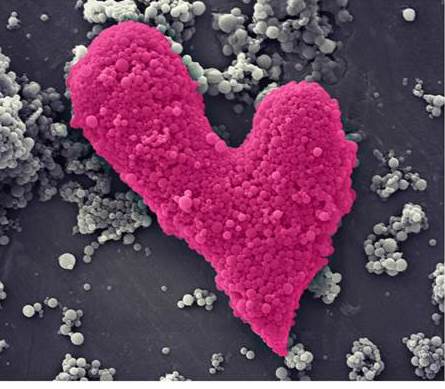Image of the Month — Love for Vaccine Development
This is an image showing a heart-shaped aggregate of microparticles, which were formulated for the development of a vaccine against Chagas disease at the Sabin Vaccine Institute and Texas Children’s Hospital Center for Vaccine Development, National School of Tropical Medicine at Baylor College of Medicine.
Microparticles
The microparticles consisted of a biodegradable polymer (poly(lactic-co-glycolic acid) or PLGA) and an adjuvant that stimulates the immune system. The polymer degrades slowly after injection under the skin and achieves sustained release of the adjuvant, increasing the effectiveness of the vaccine. This type of vaccine delivery system is prepared using a solvent evaporation technique. First the polymer and adjuvant are both dissolved in an organic solvent, and this solution is combined with a water phase containing a surfactant. The mixture is homogenized with a high-speed mixer to create a solvent-in-water micro-emulsion. The micro-emulsion is then stirred overnight so that the solvent evaporates out of the droplets, leaving the polymer and adjuvant to form solid microparticles. The microparticles are washed and freeze-dried for long-term storage.
Chagas disease
Chagas disease is caused by infection with the parasite Trypanosoma cruzi and it is estimated that 7 to 8 million people are infected and at risk of cardiomyopathy. Although the parasite is transmitted from a bite of the blood-feeding “Kissing Bug”, many newborns are also infected with Chagas disease by congenital transmission. – Leroy Versteeg, Pediatrics – Tropical Medicine




